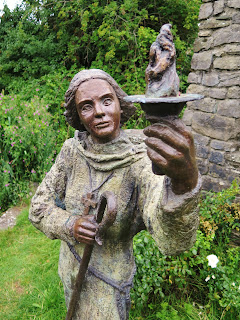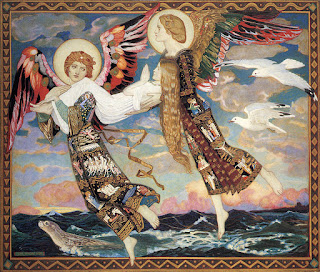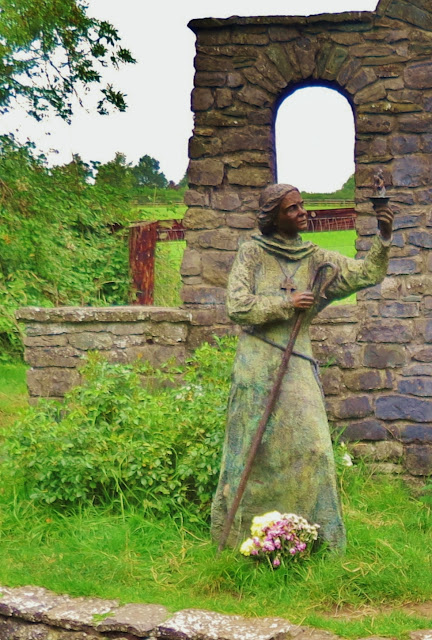Ireland has many holy wells dedicated to its patron Saint; St. Brigid. There is also a Celtic Goddess named Brighid who was worshipped long before Christianity arrived in Ireland. So what is the difference between these two and the significance of the ancient pilgrim sites dedicated to them?

I have found Ireland's myths, legends and history so enticing and also so confusing, but Brigid is by far the most intriguing for me. Many similarities between the Celtic Goddess Brighid (who is also Brigit, Bríg, Bride-pronounced breet) and the Christian Saint Brigid have scholars debating whether they are one and the same. Brigid is sometimes referred to as "Muire na nGael" or "The Mary of The Gaels," and along with Saint Patrick and Saint Colomba, Saint Brigid is Ireland's third official patron Saint. I am in no way a scholar or academic; just a travel lover, a story lover, & Goddess lover. This blog post addresses all three.
The Legend Of Brigid
 According to a book written about the life of St. Brigid in the early 600's, she was born in Faughart (also spelled Fochart) which is close to the town of Drogheda near the modern border of Northern Ireland. St. Brigid was said to have been born around the year 451 to a beautiful Pictish slave mother named Brocca and a Pagan Chieftain of Leinster named Dubhthach. Brocca was a converted Christian who was said to have been baptized by Saint Patrick himself. When Brocca was pregnant with Brigid, Dubhthach's wife, who was jealous of Brocca's beauty and the attention her husband paid to her, sold Brocca to a Druid. There is no mention of the Druid being a man or a woman since a Druid could be either-but my hunch was the Druid was a female. This Druid Priestess mid-wifed Brocca and helped to raise Brigid and I suspect the Priestess also had a hand in naming Brigid. The Druid helped to raise Brigid and let her work alongside her mother in the dairy the Druid owned, probably training her to become a Druid as well. Young Brigid gained a considerable reputation for healing the sick, feeding the poor from the dairy and performing miracles; one of them being turning water into beer. That sounds vaguely familiar for some reason 😉
According to a book written about the life of St. Brigid in the early 600's, she was born in Faughart (also spelled Fochart) which is close to the town of Drogheda near the modern border of Northern Ireland. St. Brigid was said to have been born around the year 451 to a beautiful Pictish slave mother named Brocca and a Pagan Chieftain of Leinster named Dubhthach. Brocca was a converted Christian who was said to have been baptized by Saint Patrick himself. When Brocca was pregnant with Brigid, Dubhthach's wife, who was jealous of Brocca's beauty and the attention her husband paid to her, sold Brocca to a Druid. There is no mention of the Druid being a man or a woman since a Druid could be either-but my hunch was the Druid was a female. This Druid Priestess mid-wifed Brocca and helped to raise Brigid and I suspect the Priestess also had a hand in naming Brigid. The Druid helped to raise Brigid and let her work alongside her mother in the dairy the Druid owned, probably training her to become a Druid as well. Young Brigid gained a considerable reputation for healing the sick, feeding the poor from the dairy and performing miracles; one of them being turning water into beer. That sounds vaguely familiar for some reason 😉 |
| A "Bogha Bride" or St. Brigid's Cross |
Now Brocca was the property of the Druid, but Brigid was still the property of her Cheiftan father. As the legend has it, when Brigid was 10, she was returned to the household of her father Dubhthatch and raised alongside her half-brothers and sisters. Brigid soon turned into a lovely young woman like her mother. Approaching close to marrying age, her father wanted to use Brigid's marriage to make alliances with other Pagan Chieftains. Her father brought Brigid to the court of the King of Leinster to either sell her or to find a suitable husband that would strengthen his political alliances. At court, Bridgid told the King that she did not wish to marry and become the property of a man again and that she wanted to become a Christian nun. The King of Leinster at the time was Crimthann mac Énnai a Christian King baptized by Saint Patrick like Brigid's mother. The King had heard of Brigid's miracles and convinced Brigid's father to free her from slavery as long as she promised to take the vow of Christianity. Dubthatch complied, and Brigid returned to her mother at the dairy and continued to feed the sick and poor and to also keep learning from the Druid, growing into an intelligent and formidable woman.
Brighid The Goddess
At this time, Celtic Christianity was different from Roman Christianity because of the societal structure of the Celts and their intense connection to nature; many people blended the new Christian beliefs with the old Celtic religion. The Celtic Goddess Brighid was revered all over Ireland as a life-giving Goddess of midwifery, healing, poetry, animal husbandry; especially cows which were scared to the people of Ireland dating all the way back to Neolithic times. Brighid was the virginal keeper of the flame, fire and smithcraft, representing transformation. She was also the Goddess of the Spring and her sacred day was the Celtic festival of Imbolc, celebrated on February 1st, the official start of Spring for the Celtic people.
The idea that St. Brigid was trained as a Druid was not uncommon for this time in Ireland, and many "Holy" men & women were versed in ways of the Old Region as well as the new religion of Christianity. Around the year 468, a 17-year-old Brigid took "the Veil" to become a nun, but was ordained the first Abbess in Ireland. Appointed by St. Patrick's nephew St. Mél of Ardagh who "accidentally" read the wrong ceremony and ordained Brigid as a bishop instead of a nun-whoops! St. Mél claimed the error was an act of God and did not rectify the mistake, giving St. Brigid substantial power. Brigid set out with St. Mél and his disciple St. Mac Caille to convert Pagan Cheiftans in central Ireland to Christianity. Along with St. Mac Caille (sometimes spelled Maccaille) Brigid set up an early Christian monastery at a holy well at Croghan Hill which was an ancient Pagan burial site. A group of women soon joined her there, and her community proliferated.
St. Brigid's following was growing so rapidly in fact, she decided to ask her old buddy, the King of Leinster for some land to establish her own abbey. There is a myth about St. Brigit's Cloak magically expanding to cover all the area where the King would allow Brigid to build her monastery. What is more likely, is that Brigid wanted to establish her abbey in a specific Pagan spot, later named Cill Dara so that she could carry out her work. "Cill Dara" in Irish means "Church of the Oak" and where we get the modern Irish name for the town of Kildare. Oak trees are sacred to Druids, and the site Brigid selected to build her convent was a nemeton or a Druidic sacred Oak Grove. In this sacred grove, an eternal flame burned in the honour of the Celtic Goddess Brighid and was tended around the clock by Druid priestesses. Remember the King of Leinster was a Christian, so giving Brigid a Druidic place of worship to establish her monastery was definitely a calculated move on his part.
Brigid Of Kildare
Brighid The Goddess
 |
| St. Brigid's Holy Well, Kildare |
The idea that St. Brigid was trained as a Druid was not uncommon for this time in Ireland, and many "Holy" men & women were versed in ways of the Old Region as well as the new religion of Christianity. Around the year 468, a 17-year-old Brigid took "the Veil" to become a nun, but was ordained the first Abbess in Ireland. Appointed by St. Patrick's nephew St. Mél of Ardagh who "accidentally" read the wrong ceremony and ordained Brigid as a bishop instead of a nun-whoops! St. Mél claimed the error was an act of God and did not rectify the mistake, giving St. Brigid substantial power. Brigid set out with St. Mél and his disciple St. Mac Caille to convert Pagan Cheiftans in central Ireland to Christianity. Along with St. Mac Caille (sometimes spelled Maccaille) Brigid set up an early Christian monastery at a holy well at Croghan Hill which was an ancient Pagan burial site. A group of women soon joined her there, and her community proliferated.
St. Brigid's following was growing so rapidly in fact, she decided to ask her old buddy, the King of Leinster for some land to establish her own abbey. There is a myth about St. Brigit's Cloak magically expanding to cover all the area where the King would allow Brigid to build her monastery. What is more likely, is that Brigid wanted to establish her abbey in a specific Pagan spot, later named Cill Dara so that she could carry out her work. "Cill Dara" in Irish means "Church of the Oak" and where we get the modern Irish name for the town of Kildare. Oak trees are sacred to Druids, and the site Brigid selected to build her convent was a nemeton or a Druidic sacred Oak Grove. In this sacred grove, an eternal flame burned in the honour of the Celtic Goddess Brighid and was tended around the clock by Druid priestesses. Remember the King of Leinster was a Christian, so giving Brigid a Druidic place of worship to establish her monastery was definitely a calculated move on his part.
Brigid Of Kildare
 |
| St Brigid Flame in Kildare, Ireland |
 |
| Saint Bride by John Duncan 1913 |
In the year 1993, an order of Brigidine nuns re-lit Brigid's eternal flame in Kildare, and you can see it today if you visit the Solas Bhride Centre and Hermitages. You can also see the original stone foundation of the fire temple at the Kildare cathedral and a round tower that you can actually climb to the top! Nearby is St. Brigid's holy well, located in a park-like setting, where you can feel the healing & peaceful presence of both Brighid and St. Brigid.
As far as I can tell, the radiant energy of Brighid's holy wells, pilgrim sites and churches in Ireland are the same, even if the story of Brigid may be different. I hope you have the chance to experience this energy yourself soon...
Follow me on FACEBOOK, INSTAGRAM and BLOGLOVIN' for daily photos and updates! #slowtravel🐌



No comments:
Post a Comment